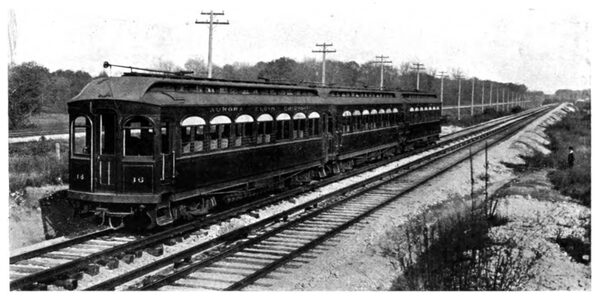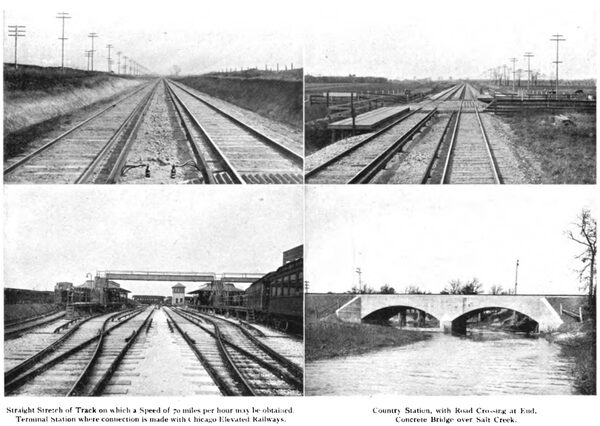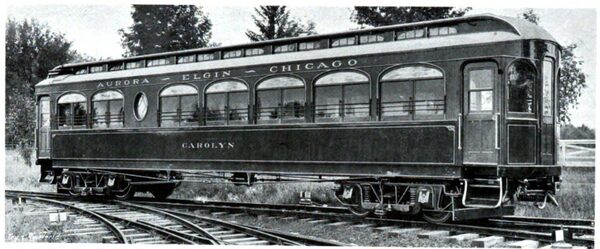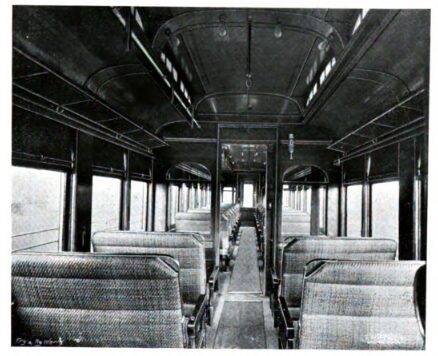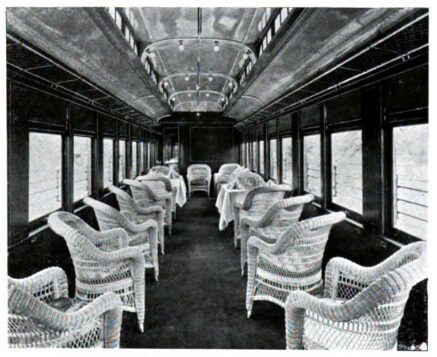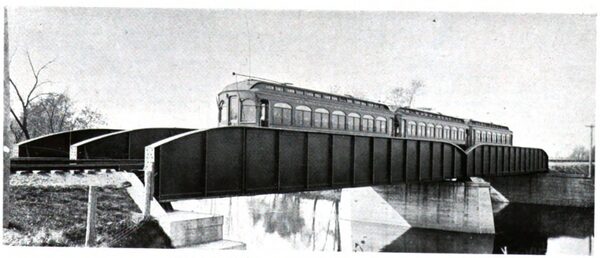[Trade Journal]
Publication: The Tramway & Railway World
London, England, United States
vol. 16, no. 29, p. 537-539, col. 1-2
AN AMERICAN HIGH-SPEED ELECTRIC RAILWAY.
A THIRD-RAIL SYSTEM BETWEEN AURORA, ELGIN, AND CHICAGO.
The Aurora, Elgin, and Chicago Railway lies just west of the city of Chicago. Its eastern terminal station is the western terminal of the Garfield branch of the Metropolitan Elevated Railway of Chicago. This station is at Fifty-second Avenue, about one and a quarter miles from the western limits of the city. The road runs directly west to Wheaton, where it divides, one branch going to Elgin, the other to Aurora and Batavia. These cities are on the Fox River, and are about equally distant from Chicago, which is about 34 miles away. The track to Wheaton (19 miles) is double, the branches being of single track, except about a mile on the Aurora division, whence a spur runs off to Batavia.
The district through which the railway passes has a population of about 97,000. If to this are added the people of the various towns along the Fox River, who are reached by a local trolley line joining Aurora, Batavia, and Elgin, the total population is over 115,000.
| |||
| A Three-Car Electric Train Provided With Shoe Collectors and Overhead Trolleys. |
The travelling facilities of the whole region were considered good before this road was built, as the district was reached by four steam railways, which run suburban trains from Chicago to Aurora and Elgin. But the population was sufficiently large and scattered to warrant the attempt of the promotion of a line to compete with these railways; yet to do so would require a railway different from any interurban one ever built in order to make it a successful venture . It was a problem , the solution of which has produced a railway that is regarded by many engineers as a step toward the use of electric traction on all suburban lines in the place of steam.
| |||
| Views on the Aurora, Elgin, and Chicago Railway. |
This line maybe described as of the third-rail type; but in construction it differs materially from the ordinary interurban roads. It dispenses with the trolley wire and feeder cables, using in their place an electrified third rail, which is sufficiently large to take the place of both trolley wire and feeder cables. Though the system is nearly twice as expensive in construction as the trolley system, and much more dangerous, in theory at least, for the "live" rail can be got at by any boy of the district who disregards warning signs, it was adopted because the trolley system could not meet the demands that would be required by the service the promoters proposed to supply.
The limit of the trolley system had been reached, both as to speed and size of trains run, by nearly all interurban roads recently built. The practical speed of a trolley car is not higher than 30 or 40 miles per hour. Even then the trolley is liable to fly off the trolley wire, and do much damage to the overhead system. In addition, the maximum current that can be taken from the trolley wire by a trolley is not greater than 1,000 amperes.
| |||
| Buffet Motor Car on the Aurora, Elgin, and Chicago Railway. |
The promoters planned and have provided that on this line the trains will run at a speed of 60 and 65 miles an hour, and they have reached a maximum speed on some parts of the road of over 75miles per hour. The current required to accelerate a car from stand-still to 50 miles an hour in 20 or 25 seconds, as is their general rule, is about 1,500 amperes for one car and a trailer, and 2,000 amperes for two cars and a trailer.
| |||
| Interior of Smoking Compartment. |
| |||
| Interior of Buffet Car. |
The equipment of the motor cars that make this remarkable speed is such as to indicate that even better speed can be made when the road-bed is thoroughly settled. Each car has four 125 H.P. GE motors, one on each axle of the double trucks on which the cars are mounted, making the total power per car 500 H.P. The trucks were furnished by the Peckham Company, and are specially designed for high speed, being built so as to prevent the rolling or jumping of the car body. The cars are supplied with Christensen air brakes and Nicholson's pneumatic sanders, which enable the driver to sand the track on curves as well as on straight track. The controller system is similar to that on the South Side Elevated Railroad of Chicago. On each platform is a master-controller, by which the driver can operate the motors of each car of the train, the trains being connected by a controller cable.
| |||
| Bridge on the Aurora, Elgin, and Chicago Railway. |
The trains are usually made up of two motor cars, which divide at Wheaton, one going to Elgin, the other to Aurora. On special days, when the traffic is heavy, through trains of one motor car and trailer are run to both Elgin and Aurora. A new departure in electric traction transportation, the addition of a buffet car, is attracting the attention of interurban railway. This car weighs 42 tons, and is equipped with four 125 H.P. No. 66 GE motors geared for 70 miles per hour. The Peckham trucks, on which the car is mounted, have extra heavy springs, and the car rides very easily even at high speeds. This car is handsomely furnished, and no doubt will be much in demand, as the large number of well-to-do people who patronise the line will appreciate this new luxury. Every effort is made to furnish good service, and the public show their appreciation by an exceptionally large and increasing patronage. The traffic this year has more than met the most sanguine expectations of the railway company's officials.

